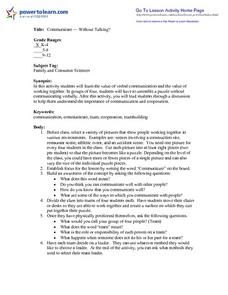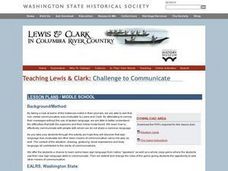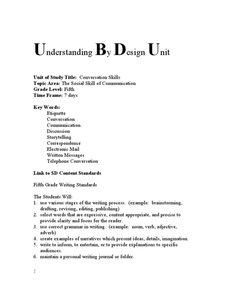Curated OER
The Artist As Entrepreneur: You Say Tomato, I See Tomato
High schoolers compare phone negotiations with in person negotiations to identify the non-verbal communication that is produced in face-to-face meetings. They practice forms of non-verbal communication by reciting the alphabet and...
Curated OER
The Human Animal
Students explore non-verbal communication. In this animal communication activity, students study body language and other forms of non-verbal communication. Students write a summary of their findings to discuss with the class. This...
Curated OER
Challenge to Communicate
Students use Lewis and Clark's journals to identify the forms of non-verbal communication they used. They discover the problems they faced on their journey and how they overcame them. They practice using the non-verbal language of the...
Curated OER
Communicate - Without Talking?
Students discuss and define communication and identify different ways of communicating with people. Students then practice team building and non-verbal communication skills as they work silently in small teams to put puzzles together.
Curated OER
Non-verbal Cues
Students distinguish between verbal and nonverbal communication. In this communication series lesson, students identify the emotions portrayed by photos shown. They role play examples of good and bad listening skills.
Curated OER
Challenge to Communicate
Students examine the journals from Lewis and Clark and identify how they spoke without using words. They participate in a game in which they use non-verbal communication with each other. They write their own journal entries to complete...
US Institute of Peace
Responding to Conflict: Nonverbal Communication
What does your posture say about you? How can it affect the outcome of conflict resolution or negotiation? Show scholars the importance of nonverbal communication during the sixth in a series of 15 peacebuilding lessons. Learners work...
US Institute of Peace
Nonverbal Communication
What is your body saying that maybe your words aren't? Scholars explore the vast world of the subtle, and not-so-subtle, nonverbal communication cues through group and individual work. Lesson seven in a series of peacebuilding exercises...
Curated OER
Teaching Lewis and Clark: Challenge to Communicate
Students note instances in the journals of Lewis and Clark where they relied on non-verbal communication (sign language.) They discover some basic sign language and play a game in which they must use their new sign language skills to...
Curated OER
Communication – The Total Impact of Your Message
Students explore the facets of verbal and nonverbal communication. In this conflict resolution lesson, students discover multicultural communication dynamics as they discuss the implications of gesture and tone. Students practice verbal...
Curated OER
Interrupting and Disagreeing Politely
Explore communication by completing argument related worksheets. Learners discuss appropriate ways to communicate with someone they are having a disagreement with and what techniques are not polite. Learners read example arguments and...
Curated OER
Giving and Receiving Compliments
Students explain why giving sincere compliments is important. In this communication lesson, students describe ways to compliment someone either verbal or nonverbal. They discuss their ideas in class.
Curated OER
Communication
Learners brainstorm the different ways about how to tell someone "no". Individually, they evaluate how they communicate with others and how they can improve. To end the lesson, they work with a partner to practice listening and...
Curated OER
Do Something
Students practice verbal and nonverbal communication in order to help clarify true feelings of tragedy. They communicate also about the gratitude for people who are community helpers.
Curated OER
Leadership
Students list the qualities of a good leader as well as the various roles of group members. They discuss how good leaders help make the group more successful and identify people in their community who are good leaders. Students offer...
Curated OER
My State of the Union
Fourth graders, in groups, research states and using various print and nonprint reference materials. The groups make a presentation to inform the class about all the information from the state. This lesson plan provides imbedded support...
Curated OER
Manners Matter
Students demonstrate proper behavior in the classroom and in other social situations. They write journal entries, create posters, invitations, and or multimedia presentations depiciting good manners. Pupils pair up with another students...
Curated OER
Everyone Eats Bread
Students identify similarties and differences between different countries and what type of bread they eat. They examine the different cultures of countries by emailing people in other countries. They also locate the country on the map.
Curated OER
The Social Skill of Communication
Fifth graders explore communication by analyzing manners. In this social skills lesson, 5th graders review the different forms of communication and how to present yourself in a phone conversation, face to face meeting, e-mail, etc....
Curated OER
Scheme of Work: Racism #3
Students act out a scene of racism using emotions, voice and body language.
Curated OER
Impact on Your Essence
Students are introduced to the use of symbolism and how it can change one's view of a piece of art. Using a piece of art, they view it as if they were the artist and create a symbol that accompanies it. They discuss the impact of two-...






















